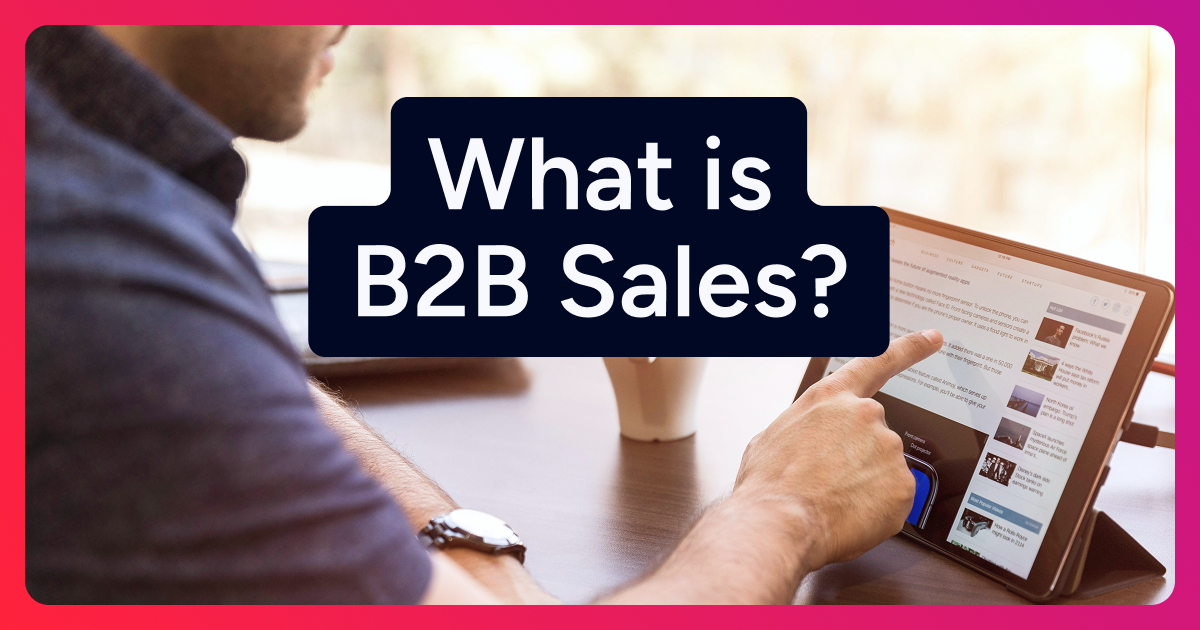B2B sales, short for business-to-business sales, describes companies that sell products or services to other businesses. It’s one of two broad ways of thinking about how companies are built: is the business model B2B or B2C (business to consumer)?
The B2B sales model is common in industries like software, manufacturing, and professional services. B2B sales typically involves longer sales cycles, higher-value transactions, and multiple decision-makers.
Unlike B2C sales models, which prioritize volume and speed, B2B selling focuses on building relationships, addressing specific business challenges, and delivering measurable ROI.
B2B sales today is radically different than it was even a few years ago, when high-volume cold calls and spray-and-pray emails could still manage to grow a business in the short term.
Business buyers are more informed, more selective, and more empowered than ever before. They’ve done much of their research long before even considering engaging with B2B sales reps and they expect a personalized, consultative experience, not a generic sales pitch.
For sales reps and GTM leaders trying to hit ambitious targets, understanding how to build a successful B2B sales engine in 2025 is the difference between predictable growth and avoidable heartbreak.
Here are the key factors to consider when building, optimizing, or overhauling your B2B sales process.
Key Characteristics of B2B Sales
Because B2B sellers are engaging with corporate buyers — and because massive contracts are at stake — the B2B buyer’s journey poses unique challenges. These considerations should shape how salespeople design their B2B sales cycle, approach prospects, build relationships, and ultimately close deals.
Here are the most important factors to keep in mind:
Longer Sales Cycles: The average length of the B2B buying process in North America varies significantly depending on the size of the company and the potential investment, with some enterprise deals taking up to a year, and requires multiple touchpoints. The challenge for sales professionals is to keep momentum alive without being overbearing.
Multiple Decision-Makers: Data from Gartner suggests that a single B2B purchasing decision can involve between six and 10 people on average. Sales reps need to craft messaging that speaks to everyone, from the CFO to the end-user who’ll actually handle your product every day.
Relationship-Driven Sales: B2B sales require building relationships based on trust and demonstrating expertise over time. Sales representatives who put in the time to craft genuine connections typically see higher close rates and greater customer retention.
Larger Deal Sizes: B2B sales contracts can range from tens of thousands to hundreds of thousands of dollars, and multimillion-dollar deals are commonplace. As a result, B2B sales reps must justify these significant investments through ROI calculations and compelling value propositions that speak to prospects’ pain points.
Data and Buying Intent Matter More: In today’s markets, B2B sales teams simply cannot afford to rely on intuition anymore. The best teams use precise lead generation strategies that allow for laser-focused outreach and guide conversations to hit on actual pain points and how solutions can help prospects achieve their goals.
The B2B Sales Process (Step-by-Step)
Every B2B startup, small business, and corporation has its own special sales techniques, but they all boil down to these same nine steps:
Define Total Addressable Market (TAM) and Ideal Customer Profile (ICP)
B2B sales teams start by defining which types of companies make ideal customers based on size, industry, technology usage, and other factors. Creating detailed buyer personas to develop Ideal Customer Profiles (ICPs) and setting realistic, attainable goals based on total addressable market (TAM) enables teams to focus on best-fit, high-value accounts with the highest likelihood of closing.
Prospecting and Lead Generation
Using data-driven B2B sales prospecting techniques, teams identify potential customers that match their ICP. Quality data ensures B2B salespeople target the right companies and decision-makers instead of spending significant time and effort cold-calling.
Lead Qualification
Not all leads deserve equal attention. Using website visitor identification tools and analyzing buying intent can help sales teams assess which prospects have the right interest, budget, and timing to make a purchase, based on historical data such as engagement history and real-time intent signals such as competitive research.
Outreach and Engagement
Personalized messaging is the key to successful outreach and engagement. Sales reps should use multiple channels, including email marketing, social selling, and phone calls, to start genuine conversations tailored to each prospect that demonstrate a keen understanding of the problems those prospects are trying to solve.
Discovery and Needs Assessment
Once connected, salespeople should dig even deeper to understand their leads’ pain points, challenges, and goals. The best salespeople position themselves as trusted advisors and partners, which requires specialized industry specific knowledge and deep familiarity with prospects’ goals and challenges.
Product Demos and Proposal
Product presentations should be a showcase of how your solution addresses the specific needs uncovered during discovery, not just a generic product tour. Effective proposals focus on outcomes and reiterate how solutions can have an immediate, tangible impact for prospects’ business.
Objection Handling and Negotiation
Even the most promising deals often involve overcoming pushback. Addressing legitimate concerns through active listening can help move deals toward closure.
Closing the Deal
Securing final approval and signatures is typically the final hurdle in the sales process, but salespeople should be ready to handle last-minute hesitations and sudden, unexpected involvement from stakeholders who may have been largely absent from the rest of the process.
Post-Sale Support and Expansion
The best B2B relationships continue growing after the initial sale. Customer success teams can ensure implementation and onboarding go smoothly, while account managers can start identifying future opportunities for mutual growth based on usage trends that may align with potential cross- and upsell opportunities.
6 Top B2B Sales Strategies for 2025
These seven strategies combine cutting-edge technology, data intelligence, and human expertise to meet the new expectations of B2B buyers who demand both personalization and efficiency in their purchasing experience.
1. Account-Based Selling (ABS)
Account-Based Selling (ABS) focuses resources on specific high-value accounts rather than casting a wide net across your entire market. ABS aligns marketing and sales efforts to create personalized experiences for priority accounts with the highest potential lifetime value.
2. Using Buyer Intent Data to Prioritize Outreach
By identifying your website’s visitors and quantifying their buyer intent, your sales teams can focus on timely opportunities that conventional prospecting workflows cannot capture. This data-driven approach dramatically improves efficiency by helping sales professionals spend their time on prospects that have demonstrated genuine interest in your product or service, or have researched competing solutions.
3. Personalization at Scale With AI and Automation
AI sales tools can help sales reps create customized outreach content at scale. However, even with large-scale personalization and AI-powered account summaries, salespeople still need to do their due diligence and demonstrate a genuine understanding of prospects’ needs to ensure interactions are efficient, but not impersonal.
4. Multichannel Prospecting
Combining LinkedIn outreach, email sequences, phone calls, and more creates multiple touchpoints and increases the chances of connecting with busy decision-makers.
Successful multichannel prospecting creates coordinated messaging that builds familiarity and trust and meets today’s buyers where they are, when they’re primed to purchase.
5. Aligning Sales and Marketing With Shared GTM Intelligence
When both sales and marketing teams work with the same data and GTM Intelligence to coordinate their efforts, leads can transition smoothly between departments without the traditional handoff friction. This alignment eliminates the gaps that often cause qualified leads to slip through cracks or receive contradictory messaging from different teams.
6. Customer Expansion and Retention
Existing customers are more likely to try new products or services and spend 31% more than new ones, making your post-sale strategy just as important as pre-sale activities. Successful B2B sales teams think of upsell and cross-sell opportunities from the outset.
Monitoring customer success metrics, conducting internal business reviews, soliciting qualitative feedback, and reaching out proactively before renewal periods can all help to maximize expansion and retention opportunities.
How To Overcome Common Challenges in B2B Sales
Even the best sales teams hit roadblocks. Here are some of the most common challenges sales teams are likely to face and how to handle them:
Reaching the Right Decision-Makers: Finding and engaging key stakeholders has become a game of hide-and-seek as companies grow more complex and. ZoomInfo’s Go-to-Market Intelligence Platform helps sales reps identify and connect with motivated decision-makers every time.
Timing Outreach To Match Buyer Intent: Connecting with prospects precisely when they’re researching new solutions is the perfect time to make the sale, but how do you know when that moment arrives? ZoomInfo’s intent data identifies companies that show real interest in what you’re selling at the moments prospects are most likely to engage.
Keeping Data Clean, Accurate, and Actionable: Information can quickly grow outdated and stale, and data hygiene is a problem for businesses of all sizes. ZoomInfo’s data governance and data management systems keep your records current and organized, while alerting teams to relevant changes and outdated leads.
How ZoomInfo Supports B2B Sales Teams
ZoomInfo’s GTM Intelligence Platform isn’t just another tool in your overflowing tech stack. We’re the backbone that makes everything else work better:
Revealing In-Market Buyers: Our intent signals and buying indicators allow sales teams to focus on eager and excited prospects, dramatically improving success rates and shortening sales cycles. Your reps can stop playing detective and start having conversations that actually move the deal forward.
Maintaining Data Accuracy: Automatically updating your contacts and managing the quality and organization of your B2B data prevents bounced emails and wasted calls, boosting productivity and keeping your salespeople on track.
Streamlining Prospecting Workflows: From research to B2B sales appointment setting and follow-up, ZoomInfo’s platform reduces manual work through smart automation. Your team can focus on conversations that matter instead of toggling between a dozen different screens.
Creating GTM Alignment: Shared intelligence between marketing, sales, and customer success teams breaks down silos and creates a cohesive customer experience. When everyone works from the same playbook, prospects stop getting mixed messages and contradictory information.
These changes in B2B sales demand new approaches, and ZoomInfo gives you a critical competitive edge in today’s markets. Start your free trial today to see how our platform can power your sales performance in 2025 and beyond.


